Multi-event relocation
Multi-event relocation is used to relocate an event catalog in offline mode.
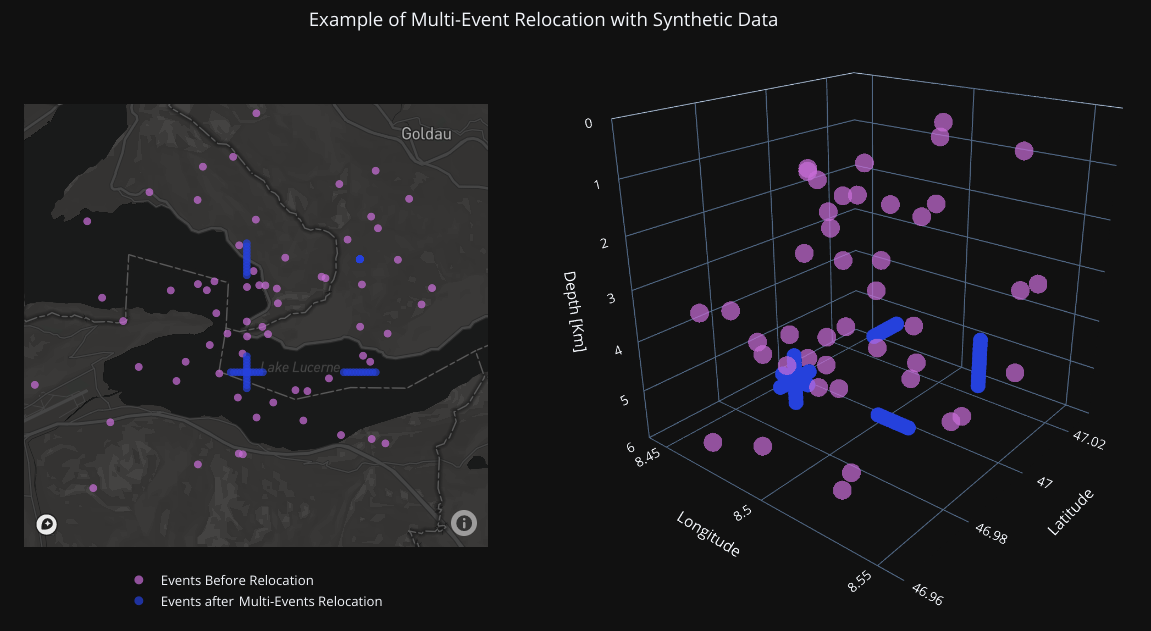
Test with synthetic data from the unit testing folder. Events from 4 clusters have their locations and times altered - using several normal distributions with non-zero mean - to simulate location/time errors. The multi-event double-difference inversion is then applied on those altered event clusters and their original locations and times are properly recovered. It is interesting to note that the relocation is performed on the 4 clusters together, in a single inversion.
Summary
Use
sclistorgcommand to select an event catalog from a SeisComP database.Create a rtDD profile (e.g. use
scconfigGUI) which defines the settings for the relocation. The default values provided by rtDD are meant to be a good starting choice, so there is no need to tweak every parameter. However, it is a good choice to configure a custom velocity model.Use
scrtdd --reloc-catalogoption to relocate the events.Use the relocation output (
reloc-event.csv,reloc-phase.csvandreloc-stations.csvor the SCML filerelocated.xml) as you please
As an example you may want to have a look at multi-event.sh script in this folder.
To relocate events not stored in a SeisComP database, refer to Relocating external data.
Getting started
To relocate a catalog (multi-event) three pieces of information need to be provided: events data, waveform data and inventory information.
Events data can be provided in three ways:
A flat file triple
station.csv,event.csv,phase.csv, which is explained later.A file containing the origin ids of events stored in a SeisComP database. In this case an utility
sclistorgmight come in handy to fetch those ids.sclistorgis distributed with rtDD and it is explained later.A file in SCML format, which is a flavor of QuakeML. It is possible to convert between formats with sccnv command .
Waveform data can to be provided in several formats, see Waveforms data for more information. The first time you try to relocate a catalog downloading the waveforms might takes some time, but then they are stored in a disk cache that avoids further downloading. Also, If the waveforms are not available (e.g. RecordStream not configured), then rtDD will proceed with the relocation anyway, but without refining the differential times via cross-correlation.
Inventory information can be stored in a SeisComP database or provided via command line (--inventory-db inventory.xml). In the latter case the inventory has be in SeisComP own station meta-data XML format called inventory ML (the SeisComP documentation provide information on how to convert from standard formats like FDSN StationXML or dataless SEED). When the events are provided as station.csv,event.csv,phase.csv file triplet, the inventory can be passed as an empty inventory ML.
The multi-event relocation itself consists in running the command scrtdd --reloc-catalog [options] with appropirate options, discussed later.
The output will be another catalog containing the relocated origins. Depending on the command line options this catalog is stored in plain text files or SCML format (which can be converted to QuakeML using sccnv command ).
In multi-event mode there is no interaction with the running SeisComP modules nor with the database. It is a safe operation and allows for easy experimentation. However, the SCML output can eventually be imported into the SeisComP database if required. That is optional.
Formats of the Event Catalog
The catalog of the events to be relocated must be stored in a format that rtDD understands.
Event Catalog: list of origin IDs
One of the compatible formats is a text file containing the origin IDs. rtDD will use the origin IDs in the file to fetch all necessary information from the SeisComP database.
E.g. file myCatalog.csv (a mandatory column named origin is required, but other column might be present too).:
origin
Origin/20181214107387.056851.253104
Origin/20180053105627.031726.697885
Origin/20190121103332.075405.6234534
Origin/20190223103327.031726.346363
[...]
There is a tool that is installed alongside rtDD, called sclistorg, that is useful for listing origin ids satisfying certain criteria, such as time period, geographic area, author, agency and so on. The output of sclistorg can then be used as the input Event Catalog of rtDD. E.g.:
# list the preferred origin ids for all events between 2018-11-27 and 2018-12-14
sclistorg --begin "2018-11-27 00:00:00" --end "2018-12-14 00:00:00" --org-type preferred [db options]
# select also the event type and the accepted agencies
sclistorg --begin "2018-11-27 00:00:00" --end "2018-12-14 00:00:00" --org-type preferred \
--ev-type "earthquake,quarry blast" --inc-agency Agency1,Agency2 [db options]
# select an area of interest, a rectangle minLat,minLon,maxLat,maxLon
sclistorg --begin "2018-11-27 00:00:00" --end "2018-12-14 00:00:00" --org-type preferred \
--area 46.0,8.5,46.5,8.7 [db options]
See sclistorg --help for a full list of options.:
Events:
--begin arg specify the lower bound of the time interval
--end arg specify the upper bound of the time interval
--modified-after arg select events modified after the specified time
--ev-type arg include only events whose type is one of the
values provided (comma separated list)
--simple Print only origin ids
Origins:
--org-type arg preferred, last or first (default is preferred)
--manual-only Include only manual origins
--auto-only Inlude only automatic origins
--inc-author arg include only origins whose author is one of the
values provided (comma separated list)
--excl-author arg exclude origins whose author is one of the
values provided (comma separated list)
--inc-method arg include only origins whose methodID is one of
the values provided (comma separated list)
--excl-method arg exclue origins whose methodID is one of the
values provided (comma separated list)
--inc-agency arg include only origins whose agencyID is one of
the values provided (comma separated list)
--excl-agency arg exclude origins whose agencyID is one of the
values provided (comma separated list)
--area arg Include only origins in the rectangular area
provided: MinLat,MinLon,MaxLat,MaxLon
Event Catalog: plain csv files
There is another format we can use to store a catalog. This format contains the full origins information, not only the origin ids. So, once the files are generated, there is no need to access the database anymore; so this format is quite fast to load. We can instruct rtDD to generate such a format starting from a list of origin IDs:
scrtdd --dump-catalog myCatalog.csv --verbosity=3 --console=1 [db options]
The above command will generate three files (event.csv, phase.csv and stations.csv) which contain all the information needed by rtDD.
E.g. file event.csv
id,isotime,latitude,longitude,depth,magnitude
1,2019-11-05T00:54:21.256705Z,46.318264,7.365509,4.7881,3.32
2,2019-11-05T01:03:06.484287Z,46.320718,7.365435,4.2041,0.64
3,2019-11-05T01:06:27.140654Z,46.325626,7.356148,3.9756,0.84
4,2019-11-05T01:12:25.753816Z,46.325012,7.353627,3.7090,0.39
Notes:
* magnitude column is currently not used
* depth is in km
E.g. file station.csv:
latitude,longitude,elevation,networkCode,stationCode,locationCode
45.980278,7.670195,3463.0,4D,MH36,A
45.978720,7.663000,4003.0,4D,MH48,A
46.585719,8.383171,2320.4,4D,RA43,
45.903349,6.885881,2250.0,8D,AMIDI,00
46.371345,6.873937,379.0,8D,NVL3,
elevationis in meter
E.g. file phase.csv
eventId,isotime,lowerUncertainty,upperUncertainty,type,networkCode,stationCode,locationCode,channelCode,evalMode
1,2019-11-05T00:54:22.64478Z,0.025,0.025,Pg,8D,RAW2,,HHZ,automatic
1,2019-11-05T00:54:23.58254Z,0.100,0.100,Sg,8D,RAW2,,HHT,manual
1,2019-11-05T00:54:22.7681Z,0.025,0.025,Pg,CH,SAYF2,,HGZ,manual
1,2019-11-05T00:54:24.007619Z,0.050,0.050,Sg,CH,STSW2,,HGT,manual
2,2019-11-05T01:03:08.867835Z,0.050,0.050,S,8D,RAW2,,HHT,manual
2,2019-11-05T01:03:07.977432Z,0.025,0.025,P,CH,SAYF2,,HGZ,manual
2,2019-11-05T01:03:08.9947Z,0.050,0.050,Sg,CH,SAYF2,,HGT,automatic
2,2019-11-05T01:03:09.12808Z,0.050,0.050,P,CH,STSW2,,HG1,manual
2,2019-11-05T01:03:09.409276Z,0.025,0.025,Sg,CH,SENIN,,HHT,automatic
Notes:
type: mutiple picks are allowed for the same event-station (P,Pn,P1,Pg,S,Sn,S1,Sg), but they must have a differenttype. However only one P and one S will be used per each event-station (seeprofile.myProfile.catalog.P|S-Phases).channelCode: used only for crossCorrelation, it specifies the channel code to use for fetching the waveform. The Orientation Code of thechannelCode(e.g.ZinHHZ) can be overridden by the parameterprofile.myProfile.crossCorrelation.p|s-phase.components.lowerUncertaintyandupperUncertaintyare used only whenprofile.myProfile.solver.aPrioriWeights.usePickUncertaintiesis set totrue
With this format it is possible to relocate events that are not stored in any SeisComP database, since all the origins information are contained in those files.
Finally, the events to be relocated can also be stored in SeisComP XML format. Please refer to the official SeisComP documentation of scxmldump, a very convenient tool for dumping events to XML file.
Relocating the candidate events
Before performing the relocation we need to create a new profile in the rtDD configuration where it is possible to select the values for the relocation steps: double-difference system creation, cross-correlation and solver.
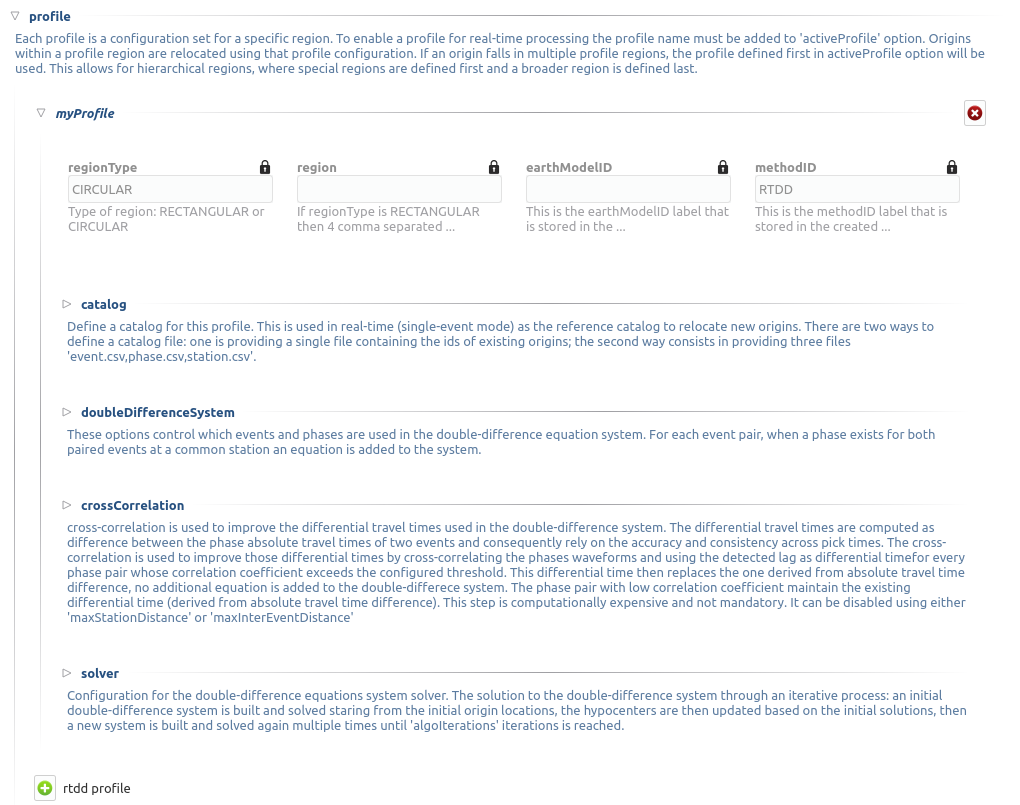
The default values provided by rtDD are meant to be a good starting choice, so there is no need to tweak every parameter. However, it is a good choice to configure a custom velocity model (solver.travelTimeTable). The cross-correlation parameters are described in a dedicated paragraph. Finally, when the configuration is ready, we can relocate the catalog with the following commands…
Relocating a file containing a list of origin ids
scrtdd --reloc-catalog myCatalog.csv --profile myProfile \
--verbosity=3 --console=1 [db options]
E.g. file myCatalog.csv:
origin
Origin/20181214107387.056851.253104
Origin/20180053105627.031726.697885
[...]
Relocating the station.csv,event.csv,phase.csv triplet
# station.csv,event.csv,phase.csv are generated with `scrtdd --dump-catalog`
scrtdd --reloc-catalog station.csv,event.csv,phase.csv --profile myProfile \
--verbosity=3 --console=1 [db options]
Relocating a XML/SCML file
Events are stored in a SCML format. It is possible to convert between different formats with sccnv command:
# events.xml contais the events data (scxmldump command)
# myCatalog.csv contains the origin ids inside events.xml we want relocate
scrtdd --reloc-catalog myCatalog.csv --ep events.xml --profile myProfile \
--verbosity=3 --console=1 [db options]
Relocating external data
The easiest way to relocate external (non SeisComP) data is to provide the event catalog in the station.csv,event.csv,phase.csv file triplet format explained above. Alternatively it can be converted from a standard QuakeML to SeisComP ML using sccnv command.
The waveform data can to be provided via -I RecordStream command line option, which support several formats (see Waveforms data for more details).
The inventory can be provided via command line --inventory-db inventory.xml. The inventory has be in SeisComP own format called inventory ML, (the SeisComP documentation provide information on how to convert from standard formats like FDSN StationXML or dataless SEED). When the events are provided as station.csv,event.csv,phase.csv file triplet, the inventory can be passed as an empty inventory ML.
Relocating a catalog in “station.csv,event.csv,phase.csv” file triplet format. In this example the data is stored in sds miniseed archive:
scrtdd --reloc-catalog station.csv,event.csv,phase.csv --profile myProfile \
-I sdsarchive:///home/sysop/seiscomp/var/lib/archive \
--inventory-db inventory.xml \
--verbosity=3 --console=1
The inventory can optionally be empty, which is not an issue if the cross-correlation is not enabled. However when the cross-correlation is used there is a restriction on the selection of the componets to be used for P and S (crossCorrelation.p-phase.components and crossCorrelation.s-phase.components): with an empty inventory rtDD doesn’t know the orientation of the sensor components and for this reason the special waveform transformations (rotation to the Transversal/Radial component, L2 norm of the horizontal components) become unavailable and should not be selected. Only real componets should be selected instead (e.g. Z, E, N, 1, 2, 3).
This is an empty inventory:
<?xml version="1.0" encoding="UTF-8"?>
<seiscomp xmlns="http://geofon.gfz-potsdam.de/ns/seiscomp3-schema/0.11" version="0.11">
<Inventory>
</Inventory>
</seiscomp>
Relocating a catalog in SCML format (the inventory is always required). The catalog and inventory were downloaded from FDSN and converted to SeisComP ML. The waveform data is fetched from FDSN:
# myCatalog.csv contains the origin ids inside events.xml we want relocate
scrtdd --reloc-catalog myCatalog.csv --ep events.xml --profile myProfile \
-I fdsnws://service.iris.edu:80/fdsnws/dataselect/1/query \
--inventory-db inventory.xml \
--verbosity=3 --console=1
Relocation Process
From a high level view the Multi-Event relocation performed by rtDD consists of few sequential steps:
clustering of the input events, where independent clusters are identified and separated for the subsequent processing steps
differential time refinement via cross-correlation (Cross-correlation).
the double-difference system creation
the double-difference system inversion
The clustering algorithm defines which event is connect to which other using configurable settings such as maximum distance and the minimum number of phases at common stations. Events are part of the same cluster if they are directly connected through a phase at a common station of if there is a path of linked events between them. If that is not the case, the event belongs to a separate clusters. Each cluster is then relocated independently.
rtDD relocates each cluster by building and solving a double-difference system that includes every event pair and their phases selected during the clustering algorithm. We recall from the Waldhauser & Ellsworth’s paper that the double-difference system is defined in matrix form as:
(1)
where G defines a matrix of size M x 4N (M, number of double-difference equations; N, number of events) containing the partial derivatives, d is the data vector of size M containing the double-differences, m is a vector of length 4N, , containing the changes in hypocentral parameters we wish to determine, and W is a diagonal matrix of size M x M to weight each equation.
To build the system, rtDD creates an equation for each phase k a pair of events i and j have at a common station. This is done for every event pair in a cluster. The equation is defined as:
(2)
One side of the equation contains the double-difference and on the other side the partial derivatives
and hypocerter changes
(
) we want to compute for the two paired events i and j so that the observed differential times equal the computed ones at a common station.
The double-difference is defined as:
(3)
and t is the travel time for the phase k for the events i and j. The observed differential time can then be computed as the difference in phase travel times using the observed picks or it can be the cross-correlation lag between the phase waveforms. The calculated travel time is the difference of the theoretical phase travel times computed using a velocity model.
The partial derivatives and hypocenter changes part of the equation (2) can be written in full as:
In order to compute the partial derivatives and the calculated differential travel times a velocity model is required. To avoid the run time computational costs of ray tracing during the inversion, rtDD is designed to support precomputed travel time tables (including velocity at source and take-off angle). See Custom velocity models.
The solution of the double-difference system as defined in (1) is the set of hypocenters changes (latitude, longitude, depth and time) that minimizes the difference between the observed and the calculated differential times. That is, each event absolute location is moved so that its relative position with respect with the other events minimizes the double-difference residuals.
This solution is achieved through an iterative process. An initial double-difference system is built and solved starting from the catalog events locations, the hypocenters are then updated based on the inversion solution and the process continues by building a new system and solving it again multiple times. This is repeated until a configured number of iterations is reached, usually between 10 and 20. At each iteration the solver also down-weighs the equations accordingly to their equation residuals (the down-weighing function follows what described in the Waldhauser & Ellsworth’s paper). The apriori equation weights can also be configured to allow cross-correlated differential times to have higher weigh than differential times computed from absolute pick time difference and/or to take into account the pick time uncertainty. Differently to what described in Waldhauser & Ellsworth’s paper the equations are not down-weighed by their inter-event distance. This is because the errors introduced by further events are already accounted for by the down-weighing by residuals: distant events have higher residuals than closer ones.
The actual solution of the double-difference system at each iteration is achieved via a least square approach. rtDD can use both LSQR (by Chris Paige, Michael Saunders) or LSMR (by David Fong, Michael Saunders) algorithms, which both can solve sparse and dense linear equations and linear least-squares problems. rtDD doesn’t offer an option to solve the system via Singular Value Decomposition, mainly due to the computational constraints of this method, which prevent it from being applied to large datasets.
Solving for both absolute and relative locations
If an absolute location method searches for the location that better explains a set of arrival times, then a double-difference location method searches for the event locations that better explains the difference in arrival times between pair of events. Since this latter method does not take into consideration absolute arrival times, but only their difference, the inversion is susceptible to a possible shift of the event cluster: the locations of the events relative to each others improve (the cluster shape), but the centroid of the cluster might shift with respect to its true location.
To compensate for this effect Waldhauser & Ellsworth offer two solutions. The first is to add four additional equations to the double-difference system - one for each coordinate direction and one for the origin time - that constrain to zero the mean shift of all the hypocenters during the inversion. Since this method is computationally efficient is also well suited for a SVD solver. However for a least-square approach, such as the one used by rtDD, Waldhauser & Ellsworth make use of regularization, that is a damped least-squares approach. The damping factor forces the solver to find the solution that not only minimizes the double-difference residuals, but also the changes to the hypocenters, preventing huge shifts in absolute locations. The damping factor also has the benefit of working on ill-conditioned systems. The effect of both techniques is that the relocated cluster centroid is placed more or less in what was the average location of the cluster events before the inversion.
rtDD implements the second approach, since its solver is least squares based. The double-difference system (1) with the inclusion of the damping factor and the identity matrix I, of size 4N x 4N - with N being the number of events, then becomes:
(4)
An empirical approach to find the optimal damping factor value is to start with a very low value to observe the pure relative locations of the cluster(s) and then increase the value until the overlall RMS (travel time table RMS) is equal or better than what it was before the inversion. The process is usually not a trade-off and the final solution improves both the residuals of the double-difference system (relative location/cluster shape) and the travel time RMS (absolute location of the clusters).
Inclusion of absolute travel time residuals in the double-difference system
rtDD includes an option that results in a modified double-difference system where both absolute and relative locations are taken into consideration. Solving such a system results in positioning the event cluster(s) in the absolute location that minimizes the overall absolute travel time residuals (the average rms of all events in the cluster(s)) while positioning the events relative to each others so that their double-differences are minimized too, as it happens in the classic double-difference inversion. This variation of the double-difference system comes from the observation that the changes in absolute travel time residuals are known during the inversions and hence they can be constrained to be zero. The equation (2) contains the travel time change for the phase k, . We can then include an equation in the double-difference system for every phase k of every event i that forces that travel time change to be equal to the travel time residual:
(5)
The double-difference system (4) then becomes:
(6)
Where K is a diagonal matrix containing the partial derivatives, r is the vector containing the absolute travel time residuals and is a scalar defining the weight we want to give to these new equations to balance their importance w.r.t. the double-difference residuals. If the sum of all the phases of all events in the system is Z, then K size is Z x Z and r size is Z. It is worth noting that in such a system, the damping factor
loses its importance and it can be set to 0 or a very low value.
In practice we have observed that, with this modified double-difference system, the relocated cluster(s) are virtually the same, but their centroid(s) are shifted to the location that decreases the average RMS of all events in the cluster(s).
Evaluating the results
Independently on how the input events are provided, rtDD will output a set of files reloc-event.csv, reloc-phase.csv and reloc-stations.csv, these contain the relocated catalog and additional statistical information. Also, enabling the scrtdd.saveProcessingFiles option makes rtDD generates multiple information files inside scrtdd.workingDirectory, including a copy of the log file.
To be good, the new locations must improve the relative locations (the residuals of the double-difference system should have decreased after the inversion), without introducing absolute location errors (the events RMS should not have increased - if that is the case the damping factor was too low) or even improving the absolute locations (if the absoluteLocationConstraint option was used). We can verify those conditions looking at the logs, where the solver prints, at each iteration, the residuals of the double-difference system and the absolute travel time RMS of the events.
The reloc-event.csv file contains even more detailed information, which allows to plot the distribution of DD residuals and events RMS before and after the catalog relocation (see columns startRms, finalRms, dd_startResidualMedian, dd_startResidualMAD, dd_finalResidualMedian, dd_finalResidualMAD where MAD is Median Absolute Deviation).
Log files are located in ~/.seiscomp/log/scrtdd.log, or alternatively, when running rtDD from the command line, the following options can be used to see the logs on the console:
scrtdd [some options] --verbosity=3 --console=1
Verbosity 3 should be preferred to level 4, since the debug level 4 makes the logs hard to read due to the huge amount of information.
A typical multi-event relocation log looks like the following:
[info] Loading profile myProfile
[info] Profile myProfile loaded into memory
[info] Starting DD relocator in multiple events mode
[info] Selecting Catalog Neighbouring Events
[info] Searching for not connected clusters...
[info] Found 3 event clusters
[info] Relocating cluster 1 (8302 events)
[info] Computing differential times via cross-correlation...
[...]
...wait for cross-correlation to complete...
[...]
[info] Catalog waveform data: waveforms downloaded 0, not available 273, loaded from disk cache 195652. Waveforms with SNR too low 28811
[info] Cross-correlation performed 1126058 (P phase 58%, S phase 42%), skipped 631012 (36%)
[info] Cross-correlation success (coefficient above threshold) 49% (556258/1126058). Successful P 56% (367483/653253). Successful S 40% (188775/472805)
[info] Building and solving double-difference system...
[...]
...details of the DD residuals and event RMS for each iteration of the solver...
[...]
[info] Successfully relocated 8243 events, RMS median 0.3294 [sec] median absolute deviation 0.0558 [sec]
[info] Events RMS before relocation: median 0.3480 median absolute deviation 0.0637
[info] Relocating cluster 2 (83 events)
[...]
[info] Relocating cluster 3 (1583 events)
[...]
Verifying DD system residuals and absolute RMS
The relevant part for the evaluation of the double-difference inversion is the following:
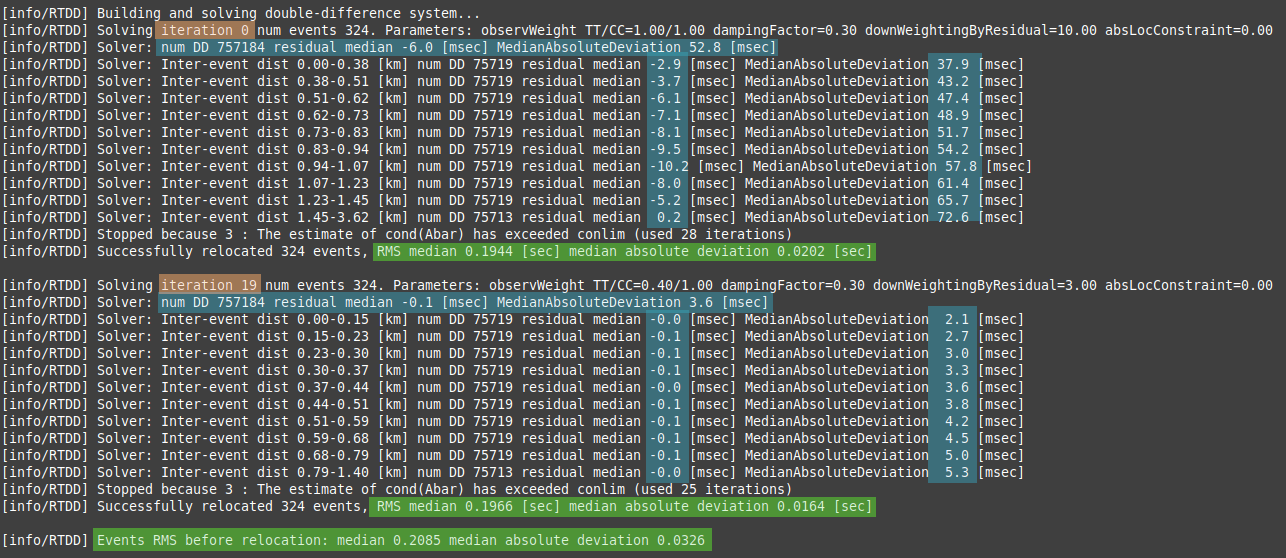
We can clearly see how the DD residuals decrease at each iteration and how they are related to the inter-event distance: the close the events the lower the residuals. Also, the absolute travel time RMS didn’t worsen, it slightly improved. That confirms we didn’t introduce absolute location errors in the cluster position during the inversion.
Verifying relative locations with cross-correlation
An independent method to evalute the correctness of the relative locations is to use the cross-correlation results. Since the waveforms similarity is indicative of the proximity of the events, that information can used to compare the cross-correlation results by inter-event distance before and after the double-difference inversion, see Cross-correlation (to avoid recomputing cross-correlations pass the xcorr.csv file generated by the relocation, see Reusing cross-correlation results).
scrtdd --eval-xcorr station.csv,event.csv,phase.csv --profile myProfile --verbosity=3 --console=1 [--xcor-cache xcorr.csv]
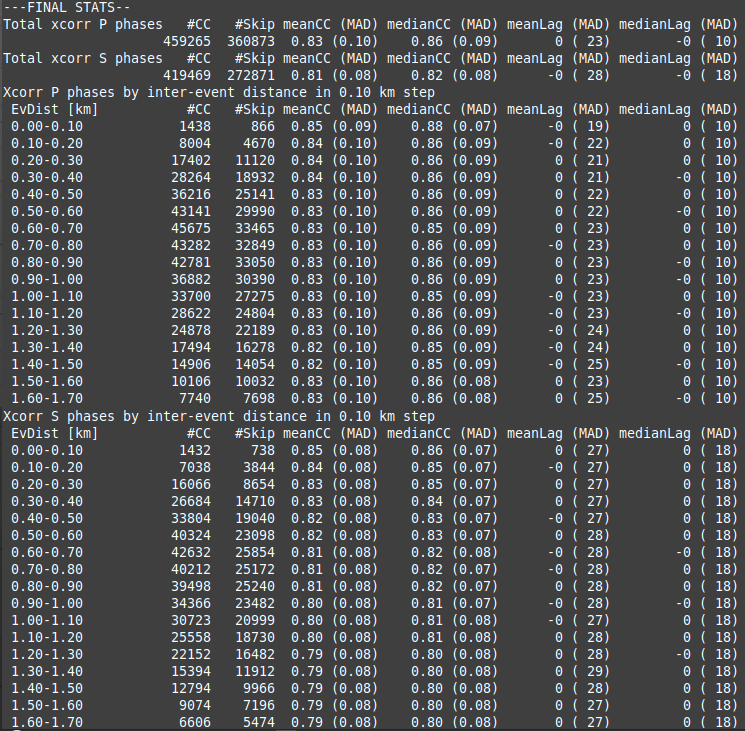
scrtdd --eval-xcorr station.csv,reloc-event.csv,phase.csv --profile myProfile --verbosity=3 --console=1 [--xcor-cache xcorr.csv]

Verifying the absolute location of the events
rtDD computes the RMS after (finalRms column in reloc-event.csv file) but also before (startRms column in reloc-event.csv file) the relocation. The computation of the initial RMS is required for a sensible comparison of RMSs. Each locator (scautoloc, scanloc, screloc, nonlinloc, scrtdd, etc) computes the RMS with a travel time table that might not be the same as rtDD. Moreover, a locator might apply a specific logic to the RMS computation, which prevents a comparison across locators. For example NonLinLoc locator weighs the residuals by pick weight, and the weighting scheme is decided by NonLinLoc, making the resulting RMS unsuitable for comparison.
Plotting startRms and finalRms allows for a sensible comparison of the absolute location of the relocated cluster(s).
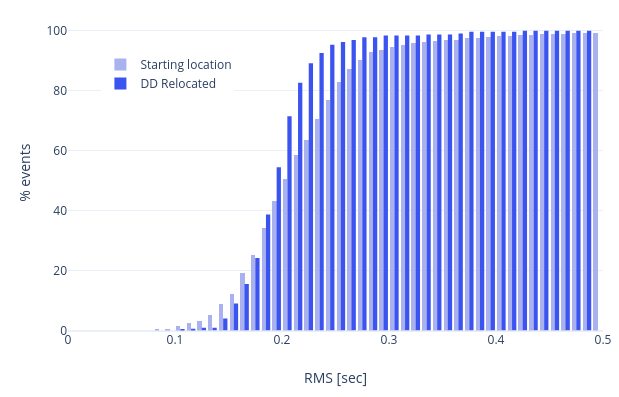
Useful options
In addition to the options we have already seen, there are also some other useful ones.
--xmlout option can be used in combination with --reloc-catalog to generate a XML output, which is useful to later insert the relocated catalog in a SeisComP database (e.g. scdb command).
E.g.:
scrtdd --reloc-catalog myCatalog.csv --profile myProfile \
--verbosity=3 --console=1 [db options]
--xmlout > relocated-catalog.xml
--merge-catalogs and --merge-catalogs-keepid are useful to merge several catalogs into a single one.
scrtdd --merge-catalogs station1.csv,event1.csv,phase1.csv,station2.csv,event2.csv,phase2.csv
--xcorr-cache option allows to reuse precomputed cross-correlations, see Reusing cross-correlation results.
--dump-clusters option allows to dump the catalog clusters that rtDD finds accordingly with the profile options.
Here is a list of all the options we have seen so far:
scrtdd --help
Mode:
--reloc-catalog arg Relocate the catalog passed as argument
in multi-event mode. The input can be a
single file (containing seiscomp origin
ids) or a file triplet
(station.csv,event.csv,phase.csv). For
events stored in a XML files add the
--ep option. Use in combination with
--profile
--ep arg Event parameters XML file for offline
processing of contained origins
(implies --test option). Each contained
origin will be processed in
signle-event mode unless
--reloc-catalog is provided, which
enable multi-event mode.
--dump-clusters arg Find clusters in the catalog passed as
argument and save them in the working
directory.The catalog can be a single
file (containing seiscomp origin ids)
or a file triplet (station.csv,event.cs
v,phase.csv). Use in combination with
--profile. The clusters will be saved
into the working directory
ModeOptions:
--profile arg To be used in combination with other
options: select the profile
configuration to use
--xcorr-cache arg Specify a file containing precomputed
cross-correlation values
--xmlout Enable XML output when combined with
--reloc-catalog or --oring-id options
Catalog:
--dump-catalog arg Dump the seiscomp event/origin id file
passed as argument into a catalog file
triplet (station.csv,event.csv,phase.cs
v).
--merge-catalogs arg Merge in a single catalog all the
catalog file triplets
(station1.csv,event1.csv,phase1.csv,sta
tion2.csv,event2.csv,phase2.csv,...)
passed as arguments.
--merge-catalogs-keepid arg Similar to the --merge-catalogs option
but events keep their ids. If multiple
events share the same id, subsequent
events will be discarded.